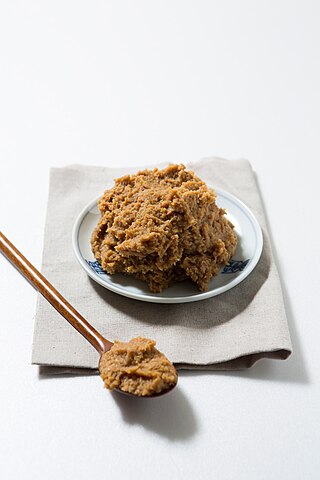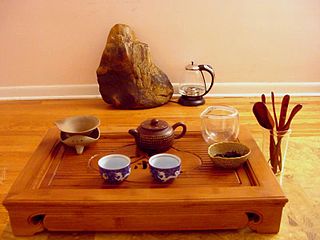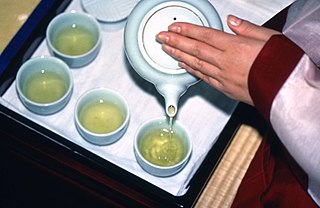
Kombucha is a fermented,lightly effervescent,sweetened black tea drink. Sometimes the beverage is called kombucha tea to distinguish it from the culture of bacteria and yeast. Juice,spices,fruit or other flavorings are often added.

Pu'er or pu-erh is a variety of fermented tea traditionally produced in Yunnan Province,China. In the context of traditional Chinese tea production terminology,fermentation refers to microbial fermentation,and is typically applied after the tea leaves have been sufficiently dried and rolled. As the tea undergoes controlled microbial fermentation,it also continues to oxidize,which is also controlled,until the desired flavors are reached. This process produces tea known as hēichá (黑茶),literally "black tea",though the term is commonly translated to English as "dark tea" to distinguish it from the English-language black tea.
The history of tea in China is long and complex,for the Chinese have enjoyed tea for millennia. Scholars hailed the brew as a cure for a variety of ailments;the nobility considered the consumption of good tea as a mark of their status,and the common people simply enjoyed its flavour. In 2016,the discovery of the earliest known physical evidence of tea from the mausoleum of Emperor Jing of Han in Xi'an was announced,indicating that tea from the genus Camellia was drunk by Han dynasty emperors as early as the 2nd century BCE. Tea then became a popular drink in the Tang (618–907) and Song (960–1279) dynasties.

Yellow tea can refer to Chinese huángchá and Korean hwangcha.

Dianhong tea is a type of relatively high-end,gourmet Chinese red tea sometimes used in various tea blends and grown in Yunnan Province,China. The main difference between Dianhong and other Chinese red teas is the amount of fine leaf buds,or "golden tips," present in the dried tea. Dianhong tea produces a brew that is brassy golden orange in colour with a sweet,gentle aroma and no astringency. Cheaper varieties of Dianhong produce a darker brownish brew that can be very bitter.

Pickling is the process of preserving or extending the shelf life of food by either anaerobic fermentation in brine or immersion in vinegar. The pickling procedure typically affects the food's texture and flavor. The resulting food is called a pickle,or,if named,the name is prefaced with the word,'pickled'. Foods that are pickled include vegetables,fruits,mushrooms,meats,fish,dairy and eggs.

Doenjang or soybean paste is a type of fermented bean paste made entirely of soybean and brine used in Korean cuisine. It is also a byproduct of soup soy sauce production. It is sometimes used as a relish.

Compressed tea,called tea bricks,tea cakes or tea lumps,and tea nuggets according to the shape and size,are blocks of whole or finely ground black tea,green tea,or post-fermented tea leaves that have been packed in molds and pressed into block form. This was the most commonly produced and used form of tea in ancient China prior to the Ming Dynasty. Although tea bricks are less commonly produced in modern times,many post-fermented teas,such as pu-erh,are still commonly found in bricks,discs,and other pressed forms. Tea bricks can be made into beverages like tea or eaten as food,and were also used in the past as a form of currency.

Gongfu tea or kung fu tea,literally "making tea with skill",is a traditional Chinese tea preparation method sometimes called a "tea ceremony". It is probably based on the tea preparation approaches originating in Fujian and the Chaoshan area of eastern Guangdong. The practice involves using smaller brewing vessels and a higher leaf-to-water ratio than in Western-style brewing. Today,the approach is used popularly by teashops carrying tea of Chinese or Taiwanese origin,and by aficionados and trained masters as a way to fully realize the taste of a tea selection,especially a finer one.

Korean tea is a beverage consisting of boiled water infused with leaves,roots,flowers,fruits,grains,edible mushrooms,or seaweed. It may or may not contain tea leaves.

Tea processing is the method in which the leaves from the tea plant Camellia sinensis are transformed into the dried leaves for brewing tea.

Lahpet,also spelled laphet,laphat,lephet,leppet,or letpet in English,is Burmese for fermented or pickled tea. Myanmar is one of the few countries where tea is consumed both as a drink and as an eaten delicacy,in the form of pickled tea,which is unique to this region. Laphet is regarded as a national delicacy that plays a significant role in Burmese society,and remains a traditional Burmese gesture of hospitality and is served to guests visiting a home.

High-mountain tea or gaoshan tea refers to several varieties of Oolong tea grown in the mountains of central Taiwan. It is grown at altitudes higher than 1,000 metres (3,300 ft) above sea level,and includes varieties such as Alishan,Dayuling,Yu Shan,Wushe,and Lishan. The high humidity and natural precipitation in the high mountain ranges of Nantou and Chiayi Counties make the region a suitable environment for growing tea plants. High Mountain Oolong is a tea that holds all of its original nutrients that are within the unfermented green tea. It does not hold the usual grass-like taste,hints of chestnut flavor paired with nutty aromas are often described. The fermentation process that removes the harsh ingredients allows the tea to taste flavorful.
Doncha,also called jeoncha,is a coin-shaped post-fermented tea produced in Korea. The tea has been called cheongtae-jeon in the Jangheung region in South Jeolla Province.

Jiuqu,also simply known as qu is a type of dried fermentation starter used in the production of traditional Chinese alcoholic beverages. The word jiuqu specifically refers to a type of yeast used to make alcohol such as huangjiu,baijiu and jiuniang.
Microbial food cultures are live bacteria,yeasts or moulds used in food production. Microbial food cultures carry out the fermentation process in foodstuffs. Used by humans since the Neolithic period fermentation helps to preserve perishable foods and to improve their nutritional and organoleptic qualities. As of 1995,fermented food represented between one quarter and one third of food consumed in Central Europe. More than 260 different species of microbial food culture are identified and described for their beneficial use in fermented food products globally,showing the importance of their use.
Symbiotic fermentation is a form of fermentation in which multiple organisms interact in symbiosis in order to produce the desired product. For example,a yeast may produce ethanol,which is then consumed by an acetic acid bacterium. Described early on as the fermentation of sugars following saccharification in a mixed fermentation process.

Pao cai,also romanized as Pao tsai,is a generic term for pickled,specifically fermented in brine,vegetables in Chinese.
Aspergillus acidus is a species of fungus in the genus Aspergillus. Aspergillus acidus can be used in food fermentation for tea.

















